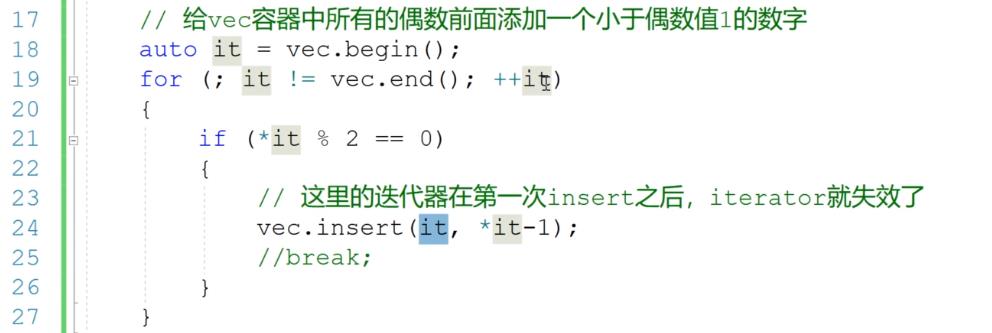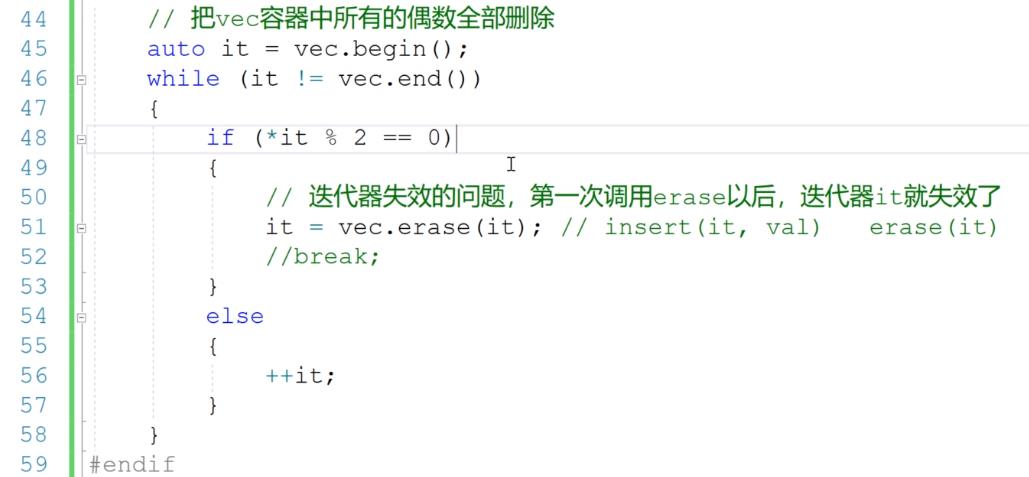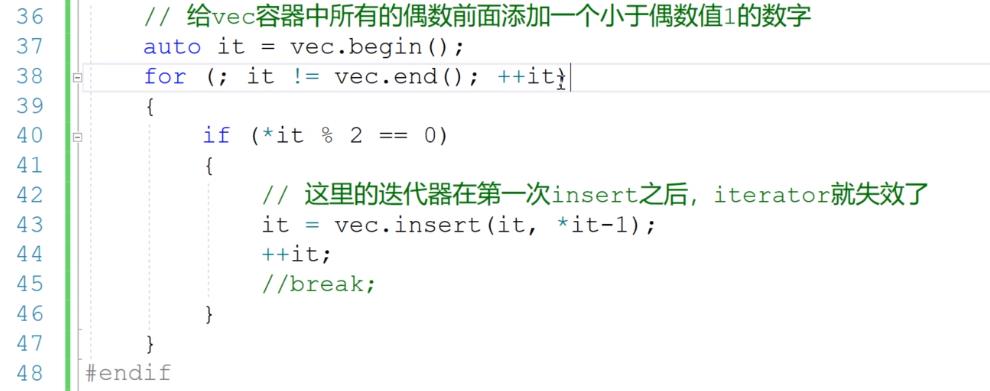13. 迭代器失效问题迭代器失效底层原理及实现
Posted 为了财务自由!
tags:
篇首语:本文由小常识网(cha138.com)小编为大家整理,主要介绍了13. 迭代器失效问题迭代器失效底层原理及实现相关的知识,希望对你有一定的参考价值。


上述程序很大可能报错!这就叫迭代器失效!(扩容也失效!)
当容器调用erase方法后,当前位置到容器末尾元素所有迭代器全部失效
当容器调用insert方法后,当前位置到容器末尾元素所有迭代器全部失效
迭代器失效后,如何解决?
对插入删除点的迭代器进行更新操作!:

erase后返回erase元素的下一个元素的迭代器!

insert后返回的是插入的元素的迭代器
迭代器失效如何实现?
#include <iostream>
using namespace std;
#if 0
// 定义容器的空间配置器,和C++标准库的allocator实现一样
template<typename T>
struct Allocator
T* allocate(size_t size) // 负责内存开辟
return (T*)malloc(sizeof(T) * size);
void deallocate(void *p) // 负责内存释放
free(p);
void construct(T *p, const T &val) // 负责对象构造
new (p) T(val); // 定位new
void destroy(T *p) // 负责对象析构
p->~T(); // ~T()代表了T类型的析构函数
;
/*
容器底层内存开辟,内存释放,对象构造和析构,都通过allocator空间配置器来实现
*/
template<typename T, typename Alloc = Allocator<T>>
class vector
public:
vector(int size = 10)
// 需要把内存开辟和对象构造分开处理
//_first = new T[size];
_first = _allocator.allocate(size);
_last = _first;
_end = _first + size;
~vector()
// 析构容器有效的元素,然后释放_first指针指向的堆内存
// delete[]_first;
for (T *p = _first; p != _last; ++p)
_allocator.destroy(p); // 把_first指针指向的数组的有效元素进行析构操作
_allocator.deallocate(_first); // 释放堆上的数组内存
_first = _last = _end = nullptr;
vector(const vector<T> &rhs)
int size = rhs._end - rhs._first;
//_first = new T[size];
_first = _allocator.allocate(size);
int len = rhs._last - rhs._first;
for (int i = 0; i < len; ++i)
//_first[i] = rhs._first[i];
_allocator.construct(_first + i, rhs._first[i]);
_last = _first + len;
_end = _first + size;
vector<T>& operator=(const vector<T> &rhs)
if (this == &rhs)
return *this;
//delete[]_first;
for (T *p = _first; p != _last; ++p)
_allocator.destroy(p); // 把_first指针指向的数组的有效元素进行析构操作
_allocator.deallocate(_first);
int size = rhs._end - rhs._first;
//_first = new T[size];
_first = _allocator.allocate(size);
int len = rhs._last - rhs._first;
for (int i = 0; i < len; ++i)
//_first[i] = rhs._first[i];
_allocator.construct(_first + i, rhs._first[i]);
_last = _first + len;
_end = _first + size;
return *this;
void push_back(const T &val) // 向容器末尾添加元素
if (full())
expand();
//*_last++ = val; _last指针指向的内存构造一个值为val的对象
_allocator.construct(_last, val);
_last++;
void pop_back() // 从容器末尾删除元素
if (empty())
return;
// erase(it); verify(it._ptr, _last);
// insert(it, val); verify(it._ptr, _last);
verify(_last - 1, _last);
//--_last; // 不仅要把_last指针--,还需要析构删除的元素
--_last;
_allocator.destroy(_last);
T back()const // 返回容器末尾的元素的值
return *(_last - 1);
bool full()const return _last == _end;
bool empty()const return _first == _last;
int size()const return _last - _first;
T& operator[](int index) // vec[2]
if (index < 0 || index >= size())
throw "OutOfRangeException";
return _first[index];
// insert erase
// #1迭代器一般实现成容器的嵌套类型
class iterator
public:
friend class vector<T, Alloc>;
iterator(vector<T, Alloc> *pvec=nullptr
, T *ptr = nullptr)
:_ptr(ptr), _pVec(pvec)
Iterator_Base *itb =
new Iterator_Base(this, _pVec->_head._next);
_pVec->_head._next = itb;
bool operator!=(const iterator &it)const
// 检查迭代器的有效性
if (_pVec == nullptr || _pVec != it._pVec)
throw "iterator incompatable!";
return _ptr != it._ptr;
void operator++()
// 检查迭代器的有效性
if (_pVec == nullptr)
throw "iterator invalid!";
_ptr++;
T& operator*()
// 检查迭代器的有效性
if (_pVec == nullptr)
throw "iterator invalid!";
return *_ptr;
const T& operator*()const
// 检查迭代器的有效性
if (_pVec == nullptr)
throw "iterator invalid!";
return *_ptr;
private:
T *_ptr;
// 当前迭代器迭代器是哪个容器对象
vector<T, Alloc> *_pVec;
;
// 需要给容器提供begin和end方法
iterator begin() return iterator(this, _first);
iterator end() return iterator(this, _last);
// 检查迭代器失效
void verify(T *first, T *last)
Iterator_Base *pre = &this->_head;
Iterator_Base *it = this->_head._next;
while (it != nullptr)
if (it->_cur->_ptr > first && it->_cur->_ptr <= last)
// 迭代器失效,把iterator持有的容器指针置nullptr
it->_cur->_pVec = nullptr;
// 删除当前迭代器节点,继续判断后面的迭代器节点是否失效
pre->_next = it->_next;
delete it;
it = pre->_next;
else
pre = it;
it = it->_next;
// 自定义vector容器insert方法的实现
iterator insert(iterator it, const T &val)
/*
1.不考虑扩容 verify(_first - 1, _last);
2.不考虑it._ptr的指针合法性
*/
verify(it._ptr - 1, _last);
T *p = _last;
while (p > it._ptr)
_allocator.construct(p, *(p-1));
_allocator.destroy(p - 1);
p--;
_allocator.construct(p, val);
_last++;
return iterator(this, p);
// 自定义vector容器erase方法的实现
iterator erase(iterator it)
verify(it._ptr - 1, _last);
T *p = it._ptr;
while (p < _last-1)
_allocator.destroy(p);
_allocator.construct(p, *(p + 1));
p++;
_allocator.destroy(p);
_last--;
return iterator(this, it._ptr);
private:
T *_first; // 指向数组起始的位置
T *_last; // 指向数组中有效元素的后继位置
T *_end; // 指向数组空间的后继位置
Alloc _allocator; // 定义容器的空间配置器对象
// 容器迭代器失效增加代码
struct Iterator_Base
Iterator_Base(iterator *c=nullptr, Iterator_Base *n=nullptr)
:_cur(c), _next(n)
iterator *_cur;
Iterator_Base *_next;
;
Iterator_Base _head;
void expand() // 容器的二倍扩容
int size = _end - _first;
//T *ptmp = new T[2 * size];
T *ptmp = _allocator.allocate(2 * size);
for (int i = 0; i < size; ++i)
//ptmp[i] = _first[i];
_allocator.construct(ptmp + i, _first[i]);
//delete[]_first;
for (T *p = _first; p != _last; ++p)
_allocator.destroy(p);
_allocator.deallocate(_first);
_first = ptmp;
_last = _first + size;
_end = _first + 2 * size;
;
int main()
vector<int> vec(200);
for (int i = 0; i < 20 ; ++i)
vec.push_back(rand() % 100 + 1);
auto it = vec.begin();
while (it != vec.end())
if (*it % 2 == 0)
// 迭代器失效的问题,第一次调用erase以后,迭代器it就失效了
it = vec.erase(it); // insert(it, val) erase(it)
else
++it;
for (int v : vec)
cout << v << " ";
cout << endl;
#if 0
auto it1 = vec.end();
vec.pop_back(); // verify(_last-1, _last)
auto it2 = vec.end();
cout << (it1 != it2) << endl;
int size = vec.size();
for (int i = 0; i < size; ++i)
cout << vec[i] << " ";
cout << endl;
auto it = vec.begin();
for (; it != vec.end(); ++it)
cout << *it << " ";
cout << endl;
// foreach
for (int val : vec) // 其底层原理,就是通过容器的迭代器来实现容器遍历的
cout << val << " ";
cout << endl;
#endif
return 0;
#endif
以上是关于13. 迭代器失效问题迭代器失效底层原理及实现的主要内容,如果未能解决你的问题,请参考以下文章
C++初阶:STL —— vectorvector的介绍及使用 | 迭代器失效问题 | vector的深度剖析及模拟实现
C++初阶:STL —— vectorvector的介绍及使用 | 迭代器失效问题 | vector的深度剖析及模拟实现